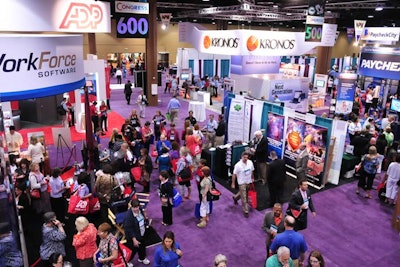
The American Payroll Association hosts a weeklong annual congress that provides educational workshops, networking opportunities, and recertification credit hours for payroll professionals. Recognizing that many of its 22,000 members can’t take time away from the office to travel to the conference, the organization created a virtual component in 2010. “It’s a supplement for those who can’t be there, to give them a taste of what is going on,” said Susan Garcia, the association’s project manager for the Virtual Congress. With that as the goal, the association provides just a sample of sessions from the conference for online attendees. Access to the Virtual Congress is free for the association’s members, and revenue comes from exhibitors and sponsors that participate in the virtual exhibit hall.
The Virtual Congress is offered on one day—in 2012 it was the third day of the in-person event, which took place in Orlando. The online program includes a taped presentation of a general session from the face-to-face conference, along with five Webcasts that combine a recorded presentation with a live Q&A segment.
Four segments are on topics created and presented by association staff—identical to sessions offered at the physical event. The fifth workshop is exclusive to the online program and sold to a vendor that chooses the subject; in 2012, Global Cash Card and Visa presented a workshop. “We moderate it and make sure it is the right length, but it is their speakers,” Garcia said. “Sponsors fight for that spot. It’s a branding opportunity that they see as a benefit. They are not doing a sales pitch; they are straight up educating.”
Last year, 2,100 people participated online on the live day. The content was available on demand for 90 days after the event, and more than 1,000 additional people accessed it during that time.
In addition to educational content, online attendees can access the virtual exhibit hall, which is only open to exhibitors and sponsors who are already participating in the in-person event. Last year, 110 exhibitors participated in Orlando, but only eight chose to pay an additional fee for an online presence. “Our bigger vendors, they get it. But there are still many companies that are scared of the technical part of virtual and hybrid events. It’s not an easy sell. Once they do it the first year, they always want to come back,” Garcia said.
The association made a change last year, partnering with INXPO for the first time and switching the online platform from Flash to HTML5. “Flash was more cutesy, but the download took much longer and it was not compatible with everything,” Garcia said. She credits the new system and its interactive features as reasons why additional online attendees spent more time in the platform in 2012. Compared to past events, the 2012 Virtual Congress saw 50 percent more sponsor space visits and a 105 percent increase in average visit time to sponsor spaces. Since exhibitors provide the only revenue stream for the Virtual Congress, the association is using these statistics to attract new exhibitors for this year. “Some of them just don’t see the R.O.I. yet. I’m showing them that these leads are instant and they are twice as many as the physical event,” Garcia said. For 2013, the association is also offering new opportunities for brands to have an online presence by sponsoring a game or the exit survey.
The virtual exhibit hall encouraged real-time interaction between sponsors and online attendees. When people clicked on a virtual booth, exhibitors received alerts that included demographic information such as the company name and its number of employees. Sponsors could engage in a one-on-one chat with visitors or greet them on the booth “wall” so other attendees would see the interaction. The new system also provided sponsors with the ability to create videos that would play automatically when an online attendee clicked on the booth. “We have found that the ones that have video greetings and demonstrations have people that stay in the booth two to three times longer, and they download more from those booths than those that just incorporate documents without videos,” Garcia said. Similar to the educational content, the virtual exhibit hall remained available on the event Web site for 90 days. Although a live chat with sponsors was not available, online participants could still access information and an email link, and sponsors received analytics indicating who had been in their booths and for how long.
To motivate people to visit the virtual booths, Garcia used INXPO’s Badge System, which rewarded online attendees with a virtual badge for each booth they visited. “It was a big selling point to our vendors,” she said. The badges appeared in the attendee’s online profile, and an online leaderboard added an element of competition. The online platform included additional interactive features to keep attendees engaged in between the Webcasts. A trivia game based on payroll-related questions rewarded participants with points, and a virtual networking lounge provided a hub for engagement.
For 2013, Garcia moved the Virtual Congress to 10 days following the face-to-face event. The change came after exhibitors said they were having difficulty staffing their booths at the in-person event while also responding to inquiries coming through the virtual exhibit hall.



















